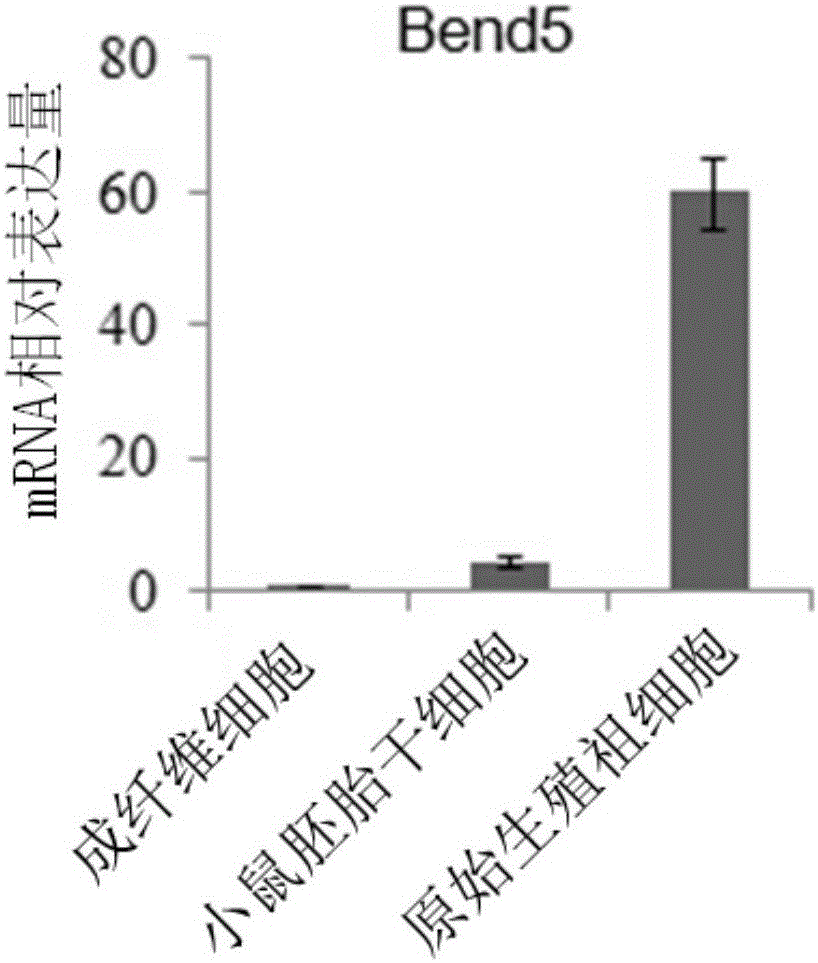Application of Bend5 protein to acceleration of induced differentiation of embryonic stem cells to into primitive reproductive progenitor-like cells
A technology of embryonic stem cells and induced differentiation, applied in embryonic cells, peptide/protein components, medical preparations containing active ingredients, etc., can solve the problem of low efficiency of fate transformation and achieve good application prospects
- Summary
- Abstract
- Description
- Claims
- Application Information
AI Technical Summary
Problems solved by technology
Method used
Image
Examples
Embodiment 1
[0066] Example 1Bend5 Gene expression in germ-like cells
[0067] 1. Real-time quantitative PCR assay to detect the expression status of Bend5 gene in germ-like cells
[0068] (1) Experimental cells: mouse embryonic fibroblasts (MEF), mouse embryonic stem cells (mES) and primordial germline progenitor cells (PGC).
[0069] (2) Breed Oct4 reporter gene mice, and use the 13.5-day fetal mice to isolate mouse embryonic fibroblasts (MEFs) and primitive genital ridges, and analyze the ratio of GFP-Oct4 by flow cytometry after the primitive genital ridges are digested, GFP-Oct4 positive cells were sorted out. After the three kinds of cells were collected, the total RNA was extracted, and the total RNA of the cells was extracted using the RNeasy kit (Qiagen Company), and the RNA was treated with DNase I (Ambion Company) at 37°C for 30 minutes to digest the DNA. cDNA was synthesized using AffinityScriptqPCR cDNA Synthesis Kit (Stratagene). Using SYBR green PCR mixture kit (App...
Embodiment 2
[0071] Example 2Bend5 Promotes germ-like cell formation
[0072] 1. Construct a stem cell line stably expressing the Stella-GFP reporter gene of Bend5. After removing the trophoblast cells, mercaptoethanol (sigma) containing 15% serum replacement (KSR, purchased from Gibco) at a final concentration of 0.1mM, 1mM Essential amino acids (purchased from Gibco), 1 mM sodium glutamate (purchased from Gibco), streptomycin / penicillin (purchased from Gibco), LIF (purchased from Millipore), 2i (purchased from Gibco) Knock-out DMEM (purchased After two generations of culture in Gibco) medium, adding cytokines such as bFGF and Acvitin A to the induction medium can promote the differentiation of mouse embryonic stem cells (mESCs) into epiblast like cells (EpiLCs). Two days later, the cells were collected for the analysis of the green fluorescent protein (GFP) signal, and the Stella-positive cells were analyzed to detect their EpiLCs induction efficiency. The expression levels of Ste...
Embodiment 3
[0081] Example 3Bend5 Promote Research on the mechanism of primordial germline progenitor-like cells
[0082] The wild-type Bend5 and the BEN domain-deleted Bend5 were constructed respectively, and the mechanism of Bend5 promoting primordial germline progenitor-like cells was studied.
[0083] 1. Experimental method
[0084] (1) EpiLC induction and flow cytometric analysis methods are the same as in Example 2.
[0085](2) Embryoid body induction differentiation experiment: count the stem cells after digestion, and resuspend the stem cells in PBS to about 1000 cells / μl. Add 1000 cells to each well of low cell binding U bottom 96 well plate (purchased from Nunc), supplement with 100 μl LIF-free ES medium, move to the incubator and culture for two days without disturbing the cells. After that, half of the culture medium was changed every day.
[0086] (3) Chromatin immunoprecipitation: cells (approximately 1×10 7 ) for 10 min, and then stop the cross-linking with a fi...
PUM
 Login to View More
Login to View More Abstract
Description
Claims
Application Information
 Login to View More
Login to View More - R&D
- Intellectual Property
- Life Sciences
- Materials
- Tech Scout
- Unparalleled Data Quality
- Higher Quality Content
- 60% Fewer Hallucinations
Browse by: Latest US Patents, China's latest patents, Technical Efficacy Thesaurus, Application Domain, Technology Topic, Popular Technical Reports.
© 2025 PatSnap. All rights reserved.Legal|Privacy policy|Modern Slavery Act Transparency Statement|Sitemap|About US| Contact US: help@patsnap.com



